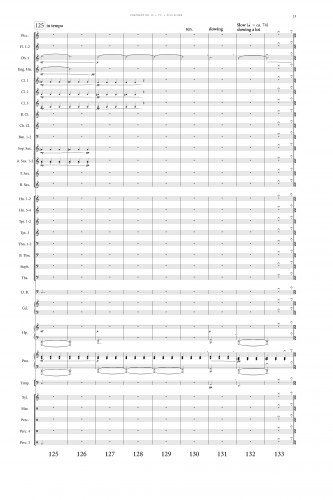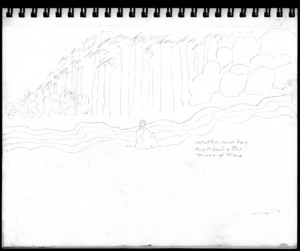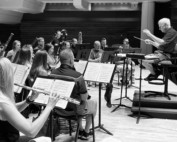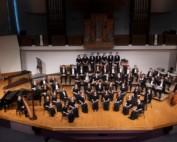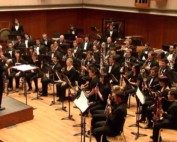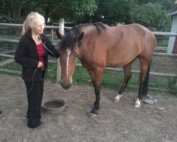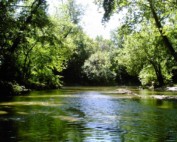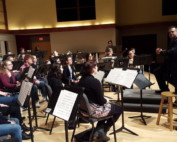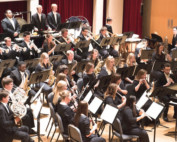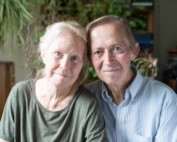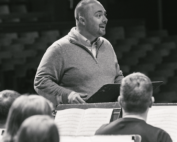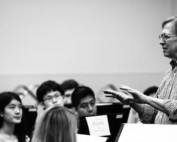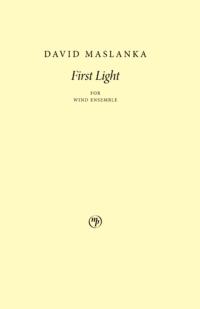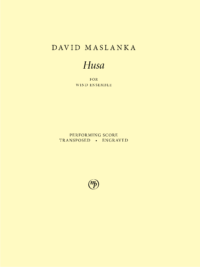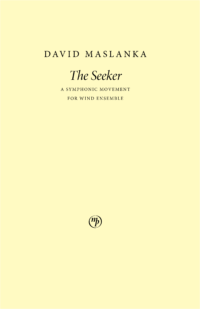Project Description
with Matthew Maslanka
Wind Ensemble
2018
40 min.
Grade 6+
Instrumentation
Picc Fl-2 Ob-2 B♭Cl-3 BCl CbCl Bsn Cbsn SSx ASx (2) TSx BSx | Hn-4 B♭Tpt-3 Trb-3 Euph Tuba | Hp Pno Perc-5
- Piccolo
- Flute (2)
- Oboe (2)
- Clarinet in B♭ (3)
- Bass Clarinet in B♭
- Contrabass Clarinet in B♭
- Soprano Saxophone
- Alto Saxophone (2)
- Tenor Saxophone
- Baritone Saxophone
- Bassoon
- Contrabassoon
- Horn in F (4)
- Trumpet in B♭ (3)
- Trombone (2)
- Bass Trombone
- Euphonium
- Tuba
- Harp
- Piano
- Percussion (6)
Movements
- Alison
- Mother and Boy Watching the River of Time
- David
- One Breath in Peace
Commissioned by
A consortium headed by Stephen K. Steele, Scott Hagen (University of Utah), and Onsby Rose (The Ohio State University)
Completed
7 March 2018, New York City
Premiere
Program Note
Symphony No. 10 was commissioned by a consortium headed by Stephen K. Steele, Scott Hagen (University of Utah), and Onsby Rose (The Ohio State University). My father passed away while writing the work. I completed the composition based on his sketches.
Dad wrote about the origins of the symphony:
The work began as always with meditation: “show me something I need to know about the piece I am going to write.” Here is the first image that came:
The Holy Mother takes me sliding down a rocky mountain slope, all loose small rocks. It’s a wild stony country, very little vegetation, many beautiful colors in large rock formations, brilliant sun. We find a large pool nestled among tall vertical rock faces. The water is turquoise blue. We go into the pool and swim/flow downward, rising again toward a circle of light. At the surface is a “divine” place of craggy multicolored rock faces. A voice speaks my name and says, “you are ready, receive what wants to come through…We are here. You go and do.”
And the second from a few days later:
I am met by the Holy Mother in the guise of an 18-year-old Swiss farm girl – blond, pretty, traditional dress. I am shown various views of the earth and the oceans. The earth is clean, the oceans are clean. Humans have come into balance with the earth and are happy. The farm girl shows me a farm full of milk cows. The world is still technological but we are living an agrarian life, I am shown a large beautiful auditorium where music is being made. The girl thanks me for what I have done to make this new world possible. This is an odd thought for me to accept.
Then came the usual problem of composing. “I” desired to write an important piece. In my vague imagination it was like one of the big symphonies of Dimitri Shostakovich, my favorite modern symphonist. But my inner compass kept dragging me away from that, and pulling back to the humble world of the chorales. A pattern began to emerge of a chorale and a response, the response being the evolution of a radically simple, intimate, and beautiful melody. This process kept repeating itself until half a dozen of these melodic pairings began to emerge – all simple, beautiful, personal, not “important”. At each step I continually questioned whether this was the symphony that needed to be: “Really? Seriously? This is what you want me to do?” – yes. Finding the structural line for the whole piece was extremely difficult. At a certain point, I sensed that a large movement wanted to happen, but it existed only as a hard little node that had begun to rise to consciousness.
At the time of his death, my father had fully completed the first movement and half of the second. The remainder of the second movement and the whole of the fourth movement were sketched out. The third movement (“the hard node”) had an opening sketched, but the rest was in fragments. Dad asked me to finish the work if he were unable to complete it. I drew on my long experience working with dad and his music to first understand the sketches and then to piece them together.
Dad titled the completed first movement after his wife and my mother: “Alison.” He was writing as my mother was dying of an immune disorder in the spring of 2017. This movement may be seen through that lens, with bitter rage at the coming loss and a beautiful song full of love.
I have named the subsequent movements. The second movement’s title, “Mother and Boy Watching the River of Time,” comes from my father’s final pencil sketch of the same name. It depicts two small figures sitting on a river bank in front of a forest and mountain foothills. The music is largely a transcription of the second movement of the euphonium sonata he wrote for me, Song Lines.
The third movement posed a special challenge. The movement was both at the emotional center of the symphony and the least finished. One tune, marked “The Song at the Heart of it All” in the sketch, became the heart of the work and of the symphony. The full statement of the theme may be found at bar 174, with a quiet restatement in the solo euphonium at bar 217. It is a pure expression of love: my love for my father, his love for me, my mother, sister, and brother, and by extension, love for humanity. The restatement of the opening material, though at first comforting, becomes jarring and unsettled, rising to a dissonant roar. The euphonium soloist is left to scream, “why?!” at world that seems content to keep spinning.
The third movement became my response to the deaths of my mother and father. It is not what dad would have written; rather, it is a synthesis of his mind and his, colored by extraordinary pain and loss. I have named the movement after my father.
The fourth movement, “One Breath in Peace,” is the acceptance and ability to move forward after loss. The long solo lines for oboe reflect and extend the bookending chorale, “Jesu, der du meine Seele”. Dad’s customary morning practice was to play one chorale from the Bach 371 Chorales. He would sing each line as he played along on the piano. In this way, he came to deeply understand these miniature jewels of western music. I have closed the symphony with the last statement of the chorale, with the pianist singing the tenor line. I hope you will hear his voice in it.
– Matthew Maslanka, April 2018
Further Reading
From the Maslanka Archive – No. 39, Wind Symphony Alumni Ensemble: Concert Recording
We are excited to feature a complete audio recording of the concert that took place on Friday, July 16, 2022 in Naperville, IL by Dr. Stephen K. Steele and the Wind Symphony Alumni Ensemble. This special event featured Angel of Mercy, Requiem, and Symphony No. 10 - The River of Time.
Stephen K. Steele & Wind Symphony Alumni Ensemble Perform to Thunderous Applause
Stephen K. Steele & Wind Symphony Alumni Ensemble Perform Symphony No. 10, Angel of Mercy, and Requiem in Naperville, IL on July 15, 2022 to a Standing Ovation of Thunderous Applause.
Maslanka Weekly: Best of the Web – No. 111, Freshly Uploaded to the Web!
Maslanka Weekly highlights excellent performances of David Maslanka’s music from around the web. This week, we are exited to feature new performances of three works just uploaded to the web in the past seven days: Symphony No. 10: The River of Time, Recitation Book, and Illumination.
Maslanka Weekly: Best of the Web – No. 108, Keitaro Harada
Maslanka Weekly highlights excellent performances of David Maslanka’s music from around the web. This week, we feature Keitaro Harada's interviews of Scott Hagan and Kevin Michael Holzman on David's Symphony No. 10 and Symphony No. 4.
Maslanka Weekly: Best of the Web – No. 103, LandesJugendBlasOrchester
Maslanka Weekly highlights excellent performances of David Maslanka’s music from around the web. This week, we feature Stefan Grefig and the LandesJugendBlasOrchester in a new magnificent performance of Symphony No. 10: The River of Time, and a classic performance of Traveler.
From the Maslanka Archive – No. 23, Onsby Rose’s Symphony No. 10 Presentation
From the Maslanka Archive features media and stories of David's life and work. This week, we are excited to feature a video of Onsby Rose giving a presentation discussing the highlights from his dissertation on Symphony No. 10: The River of Time.
Maslanka Weekly: Best of the Web – No. 91, David’s Symphonies Around the World
Maslanka Weekly highlights excellent performances of David Maslanka’s music from around the web. This week, we travel from the corn fields of Iowa - to the exciting streets of Paris - to the historic sights of northern Portugal to feature three new performances of favorite symphonies: Symphony No. 9, Symphony No. 10, and Symphony No. 5.
Maslanka Weekly: Best of the Web – No. 89, University of Texas Wind Ensemble & Symphony No. 10
Maslanka Weekly highlights excellent performances of David Maslanka’s music from around the web. This week, we feature Jerry Junkin and the University of Texas Wind Ensemble in a new performance of Symphony No. 10 as well as an interview of Matthew Maslanka by Jerry Junkin about the genesis and completion of the symphony.
Maslanka Weekly: Best of the Web – No. 74, Time
Maslanka Weekly highlights excellent performances of David Maslanka’s music from around the web. This week, we feature three of David’s works that contemplate the enigma of time: “At This Time” from Songs for the Coming Day, Symphony No. 10: The River of Time, and "A Song for the End of Time" from Song Book for Flute and Wind Ensemble.
Maslanka Weekly: Best of the Web – No. 73, New Performances of Symphony No. 10
Maslanka Weekly highlights excellent performances of David Maslanka’s music from around the web. This week, we feature two new performances of Symphony No. 10 that came as the result of Matthew being in residency with various ensembles and their conductors.
Maslanka Weekly: Best of the Web – No. 55, Alison
Maslanka Weekly highlights excellent performances of David Maslanka’s music from around the web. This week we celebrate the life of Alison Matthews by featuring three of David's works that have a movement dedicated to her: "Alison" from Symphony No. 10, "Song for Alison" from Song Book for Alto Saxophone and Marimba, and "For Pretty Alison" from My Lady White.
Maslanka Weekly: Best of the Web – No. 47, Rivers
Maslanka Weekly highlights excellent performances of David Maslanka’s music from around the web. This week, we feature three of David’s compositions that make reference to a river: Symphony No. 9, Movement I, "Shall We Gather at the River," Symphony No. 2, Movement II, "Deep River," and Symphony No. 10: The River of Time, Movement II, "Mother and Boy Watching The River of Time."
Maslanka Weekly: Best of the Web – No. 36, Symphony No. 10 & Matthew Maslanka
Maslanka Weekly highlights excellent performances of David Maslanka’s music from around the web. This week, we feature several performances of Symphony No. 10 that came as the result of Matthew Maslanka being in residency with various ensembles and their conductors.
WIU Wind Ensemble to Perform Illinois’ Premier of New Composition
Exciting week at WIU - Matthew is working with the Wind Ensemble to prepare Symphony No. 10. Check it out if you're in the area! http://www.wiu.edu/news/newsrelease.php?release_id=16185
Maslanka Weekly: Best of the Web – No. 29, Remembering David
Maslanka Weekly highlights excellent performances of David Maslanka’s music from around the web. We start the beginning of 2019 by taking time to remember the life and music of David Maslanka.
Maslanka Weekly: Best of the Web – No. 7, Tribute
Maslanka Weekly highlights excellent performances of David Maslanka’s music from around the web. This week, we remember the life of David Maslanka and Alison Matthews with unforgettable performances of Symphony No. 4, "Song for Alison" from Song Book for Alto Saxophone and Marimba, and Symphony No. 10: The River of Time.
On Composing and Symphony No. 10
David discusses his composing process and the inspiration for Symphony No. 10. This is excerpt from David's forthcoming memoir, written only months before his death.
An Introduction, Symphony No. 10, and the Future
What's next for the music of David Maslanka?
David Maslanka: Works for Younger Wind Ensembles
Here are more than twenty works for wind ensemble, arranged in approximate ascending order of difficulty, with commentary by David Maslanka
Recording the Wind Ensemble Music of David Maslanka
Mark Morette of Mark Custom Recording shares his extensive experience in recording wind ensembles.
